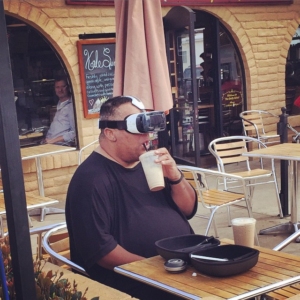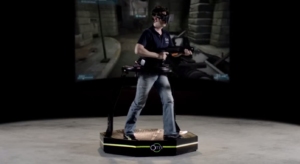Virtual reality is one of the most talked about emerging technologies in the recent years. While the idea isn’t novel, recent progress in computer graphic, haptic feedback and motion tracking technology have enabled VR with nearly infinite number of applications that present many challenges and opportunities for UX professionals. In my blog post, I will take a look at some of the factors that need to be considered in order to create a successful user experience for virtual reality.
Constraint
Understanding the constraints of VR experience dictates the level of interaction the user can have in the virtual world. Similar to UX design for other interfaces, it is important to know your users. For example, an experience targeted at young audience who are accustomed to fast movement and locomotion may allow for less constraints while an experience targeted at older audience would be limited by their physical capacity. Because VR is still nascent technology, much of VR interaction is currently constrained by hardware limitations. Most commercial VR headsets such Oculus Rift and HTC Vive still require head-end computers to run at a proper frame rate. In addition, the current crop of mainstream VR headsets are still tethered to the computers thus limiting the user movement.
Scale & Space
It is important consider the physical limitation of the space size and how that will translate into the virtual world. Will the user be wearing the VR headset in a controlled environment? Will the user be seated when wearing the VR headset? Will the virtual environment be spacious or confined? A standing user in spacious environment may allow less physical constraint when designing a VR experience. Depending on our target users’ mental state, the feelings of enclosed space in the virtual world may induce claustrophobia while large spaces may induce agoraphobia. For example, “when a pilot is in the clouds there is nothing to see outside the plane, and it can be very disorienting. When the pilot comes out of the clouds and sees the ground and sky meeting at the horizon, the pilot can orient” (Gibson, 2015). Users can find themselves in such situation in a poorly designed virtual environment, causing inevitable motion sickness. The ground to horizon relationship is as important in VR as in our physical reality (Ravasz, 2016)
Interaction
Because the wide-view, stereoscopic display creates a three-dimensional image that encourages depth and perspective, VR experience has to be designed in a 360-degree view. We should look at the placement of virtual objects because 20 metres is the limit to stereoscopic separation, meaning that parallax will be lost past this point. Contrastly, 0.5 metres becomes straining on the eyes due to constraints of the hardware’s fixed depth of field (Shanahan, 2016)
The level of interaction with the virtual environment is often determined by the tools available to the user. The affordance of VR interaction is highly dependent on the proper coordination of responsive controllers, motion tracking sensors and other hardware inputs. Depending on the target user’s physical constraint, the user may have the ability to move around the environment using hand controllers or a VR treadmill.
While accurate movement tracking is important for creating an immersive experience, it also produces feedback. Visual, auditory, haptic feedback become even more critical in VR because of the low barrier to distract a user. Buttons and links of 2D interface become just portals and objects in the virtual world. It’s important to surface feedback in some form and to do so consistently so users understand what “rules” they have for invoking objects and actions (Anderson, 2015)
We can also use spatial audio to enhance immersion or to provide action cues. For example, in virtual reality, changing the environment is just a click of a button. For the user, these sudden and overwhelming changes can cause sickness and confusion. A gentle introduction to the new environment can be achieved by fading-in the ambient soundscape of the place at first, then the image. This allows to build a mental image of the environment via sound, lowering the shock factor (Ravasz, 2016)
What does it mean for UX professionals?
Because VR experience transcends pure aesthetics and requires a level of design thinking that encompasses visual and interaction design, we need to look beyond Graphical User Interface and rethink user experience in the digital world. Designing for VR should not mean transferring 2D interface practices to 3D, but finding a new paradigm. As UX professionals, we need to educate ourselves on subjects such as psychology, architecture, sound design, lighting design and physics to prepare for the changing landscape of human-computer interaction.
Reference
Gibson, James J. The Ecological Approach To Visual Perception. New York, NY: Psychology Press, 2015. Print.
Jonathan Ravasz, Design Practices in Virtual Reality, 2016, https://uxdesign.cc/design-practices-in-virtual-reality-f900f5935826
Kelsey Shanahan, 6 Key Design Considerations in Starting a Virtual Reality Project, 2016, https://medium.com/inbeta/design-for-virtual-reality-6-key-considerations-98fb65df57c9
Samantha Anderson, You’re The Center of The Universe: A UX Guide to Designing Virtual Reality Experiences, 2015, http://www.dtelepathy.com/blog/philosophy/ux-guide-designing-virtual-reality-experiences

